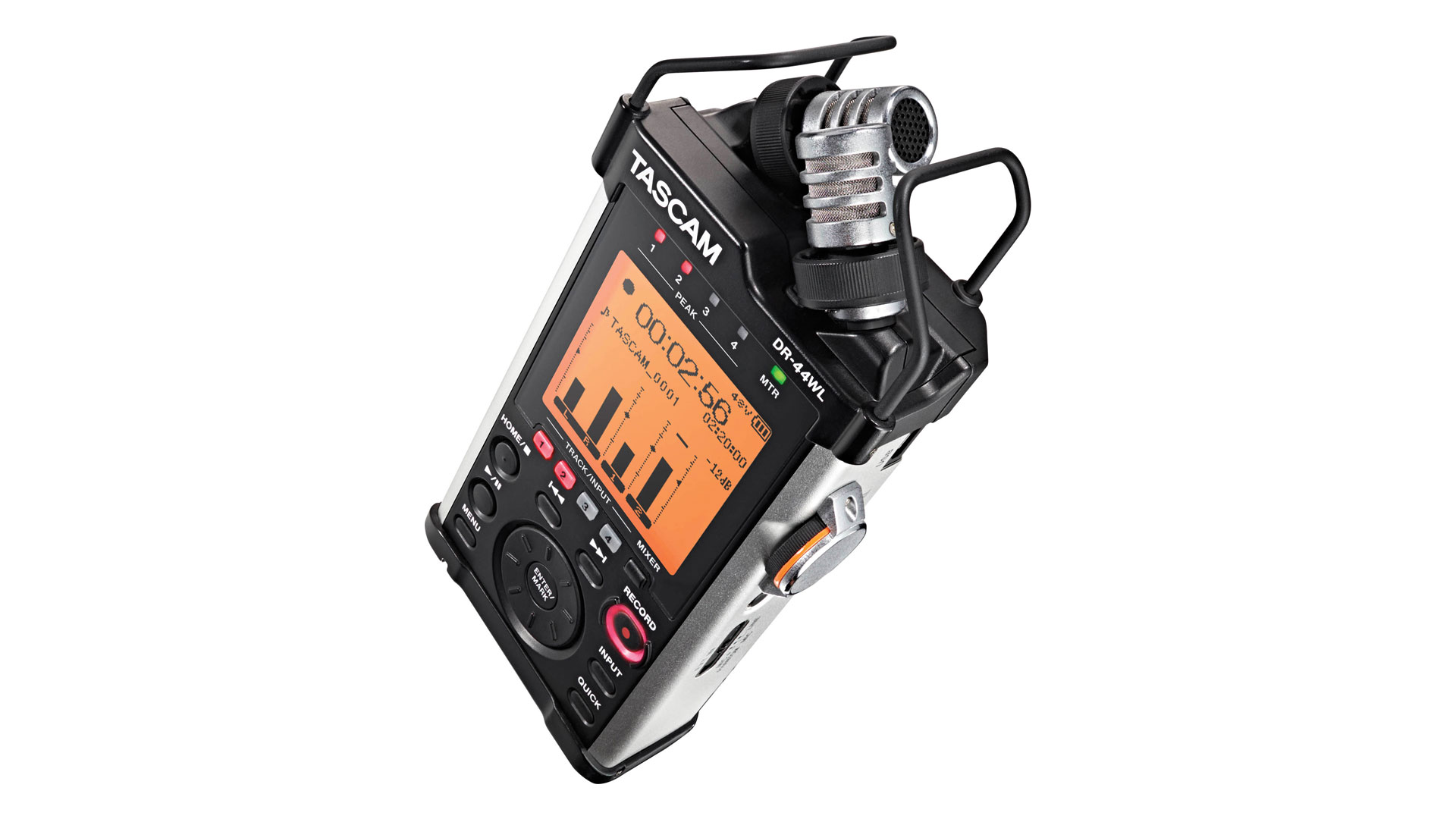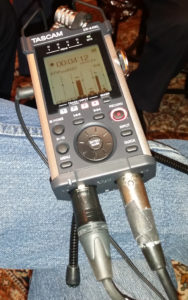I have been a big fan of TASCAM digital recorders for some time. I’ve reviewed a few over the years: the DR-100, the DR-40 and now the DR-44WL. I’ve used the DR-40 for a number of jobs over the years — everything from lectures to radio commercials. I found it super-useful, but sometimes when I’m short-handed (alone and on camera), I find myself wishing I had a remote control to start and stop or adjust levels. When the DR-44WL was released, with the main upgrade being Wi-Fi, I thought, “That’s the recorder I need.” After an extended period of lost e-mail and missed connections on both sides, I caught up with TASCAM at the January 2018 NAMM show in Anaheim, CA, where they gave me a unit to take home. A few weeks later, I received some TH-MX2 studio headphones to complete the TASCAM package.
Once I got home, I immediately noticed that there were a lot more accessories than those that came with the DR-40, which included only a 2 GB SD card, batteries and a cloth sleeve. The DR-44WL came with a ton of useful accessories, including a windscreen, a 4 GB microSD card (and adapter), batteries, hand grip, and a case — pretty much everything you need to get started and then some. Next, I downloaded the TASCAM “DR control” app for my Android Samsung S5 phone. I also downloaded the iOS version for a dilapidated iPad a friend gave me to use in my tech experiments. Syncing the mobile devices to the DR-44WL was very easy, and seemed to work well next to it on a table. I would test it later at distances.
The first job (if you want to call it one) I used it on was my kids’ school’s play. Using an older Sennheiser G2 wireless system, I hooked the camera into the main soundboard to pick up the dialog and placed the DR-44WL on the piano, which wasn’t being piped through the board, and used the unit’s on-board mics. Since music wasn’t playing the whole time, my plan was to use the Wi-Fi control to start and stop the recorder as needed. I did a quick start/stop test while setting it up, and all seemed good. When the play started, I tried to start the recording from the app with no luck. I had to wait 15 minutes for the first scene change to go up and do it manually. At first it seemed to work, and then it didn’t. The sound I did get was excellent.
My next audio project was recording an interview with a 95-year-old Holocaust survivor and Israeli Independence War veteran. For this I plugged a Shure SM58 (for the survivor) and a Behringer mic (for the interviewer) into the respective XLR inputs. Again, the recorder performed great while I used the on-board controls, which are accessed through a big wheel on the front, like early iPods. It is a bit tricky toggling between the level screen and the mixing screen, but once you get the hang of it, it isn’t too bad. I would prefer to use the app, which theoretically allows you to do it all through a touchscreen. In any event, the client was very happy with the resulting interview, which will be used on a university website.
The next production I used the DR-44WL on was an event that honored survivors and memorialized Jewish victims from the Carpathian region of Europe that suffered under the Nazi occupation, deportations and slaughter. Part of the program celebrated the now largely lost culture of the Carpathian Jews through music. I set up the DR-44WL on a micro tripod on the piano, with one of the built in mics facing the piano and the other facing the violin. I intended to use the app to start and stop the unit, as I was about 40 to 50 feet away in back, running the camera. Once again, even though the app worked from four feet away, I lost control of it when I was back by the camera. So I let it record the whole event instead of just the parts I wanted. The parts I needed — the national anthems of the United States of America and Israel and Yiddish music — sounded great. Even though the violin and piano were only a few feet apart, you could distinctly hear each instrument on its microphone. It almost sounded like the recording was done in a studio.
Additionally, the TH-MX02 headphones ($99) worked great in the field with cameras as well as in the studio while editing. Ironically, because I was setting the DR-44WL remotely, I never used the headphones directly with the DR-44WL. But I can see why these headphones are frequently sold out. The plastic around-ear cushions can make you sweat a bit, but you just need to let it breathe and wipe them every so often.
Since the Wi-Fi control was a recurring issue, I contacted TASCAM about the matter. They confirmed that the device had about a 20-meter (60-foot) range. I was no farther than 17 meters (50 feet) away, so range shouldn’t have been an issue on my shoots. We tried a number of different configurations on both Android and iOS, and I got consistent control only at 5 meters (15 feet). That’s useful if you’re recording a live performance with the unit on stage and controlling it from the front row, but not from the back of the venue, where most cameras would be set up. TASCAM acknowledged that Wi-Fi control could be affected if a lot of other mobile devices are in use in the immediate area. Well, in a room with 200 parents, you can bet there were at least 200 mobile devices, along with the school’s own Wi-Fi system. The DR Control app was doomed. This is one of the same venues where I had similar issues when testing Azden’s Pro-XD digital wireless system, which used the same bandwidth as Wi-Fi. TASCAM said a number of artists use the Wi-Fi control for recording in their home studios. That makes sense to me, as there should be little external Wi-Fi interference in somebody’s own, solitary music creation cave.
The DR-44WL gave me excellent recordings overall, but the question is whether it’s worth paying an extra $70 over the DR-40, which has many of the same features, given that its Wi-Fi connectivity may not be reliable on real-world shoots. Well, the DR-44WL also has a larger screen that makes it easier to see what is going on, and it has controls that make it easier to navigate. And, comparing on-board mics, I thought the richness of the sound was a bit better on the 44WL — though its mics are fixed in an X-Y pattern, while the DR-40 mics can be moved from the X-Y pattern into an A-B pattern. So even if you don’t use the Wi-Fi feature, the 44WL may be worth the extra money — but don’t waste any time, as it is starting to disappear from retail. But if $70 will break your bank, you won’t go wrong with the DR-40 either. (For more, read my earlier review of the DR-40.)











